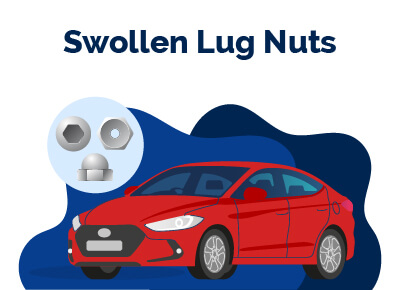Swollen Lug Nuts (Key Causes & Fixes)
June 10, 2023


Chris is Head of Content for FindTheBestCarPrice and is based out of Philadelphia, PA. As a seasoned automotive industry analyst and car enthusiast, he ensures the highest level of quality across all our content and curates our picks for the best deals each month.
Chris studied information systems and marketing at Drexel University and writes about a wide range of topics ranging from car buying tips to troubleshooting common mechanical issues.
When he’s not thinking about cars, he likes to stay in with his dog and make an “attempt” to finish a crossword puzzle (he’s not quite at the Saturday/Sunday level…yet). As a former cheesemonger, Chris still has a “sharp” passion for all things cheese, and his fridge is always loaded with it!
Chris also has a passion for things that go fast, and drones are no exception. He spends some of his time writing for Dronesourced.
There's nothing more annoying than being billed $100 to $150 by a repair shop just because they need to replace your swollen lug nuts.
But wasn't it your fault? How did your lug nuts become swollen in the first place? This has been the situation for a lot of Ford drivers.
It's hard to own a Ford without battling with issues regarding swollen lug nuts. However, it's dangerous to overlook the state of your lugnuts or regard the issue as irrelevant.
Aside from the fact that swollen lug nuts make it impossible to remove your tires, they also pose great risks to your safety. For you to understand how to stop your lug nuts from swelling or fix swollen lug nuts, you need to understand the reason why they are swollen.
In this article, we'll address all you need to know about swollen lug nuts, the dangers they pose, and how you can replace them.
Table of Contents
Are Swollen Lug Nuts Dangerous?
Yes. Swollen lug nuts are not bad enough to cause accidents or hugely impact your driving conditions, but they are dangerous because they can create a lot of inconvenience for you.
Those swollen lug nuts will add up a lot of expenses to your repair cost, and they can also leave you stranded in the middle of the road.
Imagine a scenario where you have a flat tire but can't get the wheels off because you have swollen lug nuts. This can pose safety risks, especially if your car breaks down in a lonely space at an ungodly hour.
You'll need to tow your car to a repair shop, where they'll bill you almost $8 to fix one lug nut. When you do the math for five nuts per wheel, that $40 can really start adding up.
Swollen Lug Nuts: Causes
The cause of swollen lug nuts can range from moisture to heat and even beyond that. Understanding why your lug nuts are swelling will help you decide how to fix them.
Here are some of the common causes of swollen lug nuts.
1. Low-Quality Materials and Poor Engineering Decisions.
One of the major reasons why lug nuts are swollen is due to low-quality materials and poor engineering decisions. In the mid-2010s, Ford had numerous complaints about most of its cars; fusion, escape, focus, F-150, flex, and even the F-350. These complaints emphasized the poor design structure that Ford adopted for its lug nuts.
Most users complained that in the bid to cut costs, Ford used a blend of chrome, aluminum, or stainless steel for its cap and core. This is compared to the fact that they should all be made of pure steel.
The blend of these materials was rumored to cause delamination and swelling, especially during temperature changes or exposure to moisture. This continued for a long time, even till a class action was filed against Ford for using inferior designs that neglected the safety and satisfaction of users.
2. Moisture.
The presence of water and wetness are some of the major reasons why lugnuts usually swell. The presence of moisture isn't the primary cause of lug nut swelling, but it can cause those nuts to corrode, which will, in turn, cause them to swell.
At this, you should have already known that lugnuts are pieces of metal, probably a steel nut and a chrome or aluminum cap. If moisture enters the space between the aluminum cap and the steel lug nut, corrosion starts.
Things will only get worse if road salt or other chemical elements finds its way to interact with the corrosion. The corrosion increases, rust builds, and the entire lug nut structure is heavily altered.
3. Heat.
Just like moisture, heat can swell your lugnuts. Swollen lugnuts are easily caused by heat. In the event of a temperature change, or the temperatures hit high altitudes, the lugnuts stand a high chance of swelling.
However, this is easy if the juts are made of low-quality metals or already damaged. As the expansion continues, the cap will be damaged, affecting the entirety of the lugnuts.
It is important to mention that your tires can also build up heat and pressure, heat and pressure big enough to alter the size of your lugnut.
4. Force and Poor Handling.
Nothing damages lugnuts faster than the use of force or poor handling of these items. For instance: the use of impact sockets can wreck huge damage to the lug nuts, especially during tire rotations, servicing, wheel alignment, or removal.
Some technicians will make the mistake of using cheap impact sockets or, in some cases, sockets that don't align with the nut-like using a standard-size hex socket for a metric hex nut.
Considering the difference in the size and design, there are chances that the socket will damage, loosen up or crack the chrome metal cap, giving room for water and road salt, which will, in turn, cause corrosion.
5. Tightened Too Hard.
This is usually overlooked, but overly-tightened lugnuts stand a higher chance of swelling. Tightening your lugnuts too hard can cause them to swell.
What Happens When Lug Nuts Swell?
Quite a few things happen when your lug nuts are swollen. Looking out for these signs and pointers will help you know when your lugnuts are bad and need replacement.
Here are a few common things that happen when your lugnuts are swollen:
When the lug nuts swell, the wrench will no longer fit.
The issue usually happens when the lug nuts have been tightened too tight, or maybe heat or moisture expanded its size. When this happens, it is difficult to find a socket wrench that will be fit enough to match the nuts.
Lugs have visible bulges.
To properly notice this swelling in your lugnut, you can look out for bulges by the side of the nuts. The nuts will not necessarily swell at the top but by the sides.
How Do You Get Rid of Swollen Lug Nuts?
So, you have swollen lug nuts, and you wish to know how to remove the swollen lug nuts.
Here are easy steps to get rid of swollen lug nuts.
1. With the Use of a Socket.
If you wish to get rid of swollen lug nuts, then you should consider getting a 19.5mm flip socket, in addition to a half-inch socket extension and socket breaker bar.
If you're lucky to get a 19.5-inch flip socket, you have an 18.5 socket on one end and a 19.5-inch socket on the other end. This will cover the increased size of the lug nuts after they swell. After fitting the flip socket, plug in the extensions and lose all the swollen nuts.
2. By Applying Little Pressure.
In some cases, the flip socket wouldn't easily get rid of those swollen lug nuts, so you might need to apply a little pressure. You'll use the same 19mm impact socket, in addition to a soft wood plank, hammer, and a punch or ram.
Fit in the socket if it couldn't fit in properly. Place the wood at the end of the socket and hit it gently with the hammer. This will gently push the socket into the lugnuts.
When the socket fits properly, use the extension breaker bar to lose it completely. However, there are chances that the nuts will get stuck in the sockets, and you'll need to damage the nut to pull it off.
Whichever method you find comfortable, it's important that you apply extra precautions to avoid damaging your rims. However, these DIY steps will save you a couple of dollars that you should have spent on a repair shop.
How Do You Stop a Lug Nut From Swelling?
Stopping your lugnuts from swelling isn't rocket science. You need to learn how to do it.
Here are a few things to do to stop your lugnuts from swelling.
- Keep them dry and clean.
- Replace your lugnuts with aftermarket lugnuts, especially if you're driving a Ford. Comparisons on the quality and specifications of those brands will guide you in making better choices.
- Handheld wrenches can prevent swollen lug nuts more than power wrenches can.
- Use only correctly sized sockets.
- Always seek professional help if you can't do it yourself.
Conclusion
Swollen lugnuts are a common phenomenon, especially among Ford drivers. Having swollen lug nuts doesn't make you a bad driver or one that isn't big on maintenance. You just have to learn how to fix it and replace the nuts immediately, just as soon as you find them.
Best Car Deals by Category
Frequently Asked Questions
Is it OK to lubricate lug nuts?
It is not OK to lubricate lug nuts. There's an endless argument about whether drivers should lubricate their lugnuts or not. We can tell you for free that you should never think of lubricating your lug nuts.
Those nuts aren't designed to receive grease, anti-seize compound, or any lubricant or rust removal solvent. Using lubricants on your lugnuts increases the risk of having loose wheels.
Can I drive with swollen lug nuts?
Yes, you can drive with swollen lug nuts, but we advise you should not try that. Swollen lugnuts wouldn't impact your driving ability or pose a grave danger to your safety.
However, the chances that your tires might fail in the middle of nowhere and you can't fix it because you're driving with swollen lug nuts - this is not what any driver will want to experience.
Posted in Car Buying Tips, Car Troubleshooting |




